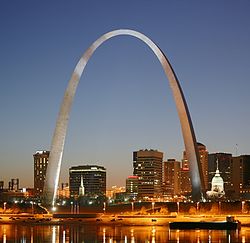
Back Geatweġbīeġels ANG قوس جيت واي Arabic Арка в Сейнт Луис Bulgarian Gateway Arch Czech Gateway Arch Danish Gateway Arch German Πύλη για τη Δύση Greek Pordega arko Esperanto Arco Gateway Spanish Gateway Arch Estonian
| Gateway Arch | |
|---|---|
 | |
 | |
| Alternative names |
|
| General information | |
| Architectural style | Structural expressionism[1] |
| Location | 100 Washington Avenue St. Louis, Missouri, 63102, U.S. |
| Coordinates | 38°37′28″N 90°11′05″W / 38.6245°N 90.1847°W |
| Construction started | February 12, 1963 |
| Completed | October 28, 1965 |
| Inaugurated | June 10, 1967 |
| Cost | $13 million (c. $95.9 million in 2023)[2] |
| Height | 630 ft (192 m) |
| Dimensions | |
| Other dimensions | 630 ft (192 m) width |
| Design and construction | |
| Architect(s) | Eero Saarinen |
| Architecture firm | Eero Saarinen and Associates |
| Structural engineer | Severud Associates |
| Main contractor | MacDonald Construction Co. |
| Website | |
| www | |
Gateway Arch | |
| NRHP reference No. | 87001423 |
| Significant dates | |
| Added to NRHP | May 28, 1987[3] |
| Designated NHL | May 28, 1987[4] |
The Gateway Arch is a 630-foot-tall (192 m) monument in St. Louis, Missouri, United States. Clad in stainless steel and built in the form of a weighted catenary arch,[5] it is the world's tallest arch[4] and Missouri's tallest accessible structure. Some sources consider it the tallest human-made monument in the Western Hemisphere.[6] Built as a monument to the westward expansion of the United States[5] and officially dedicated to "the American people", the Arch, commonly referred to as "The Gateway to the West", is a National Historic Landmark in Gateway Arch National Park and has become a popular tourist destination,[4] as well as an internationally recognized symbol of St. Louis.
The Arch was designed by the Finnish-American architect Eero Saarinen in 1947, and construction began on February 12, 1963 and was completed on October 28, 1965,[7][8] at an overall cost of $13 million[9] (equivalent to $95.9 million in 2023).[2] The monument opened to the public on June 10, 1967.[10] It is located at the 1764 site of the founding of St. Louis on the west bank of the Mississippi River.[11][12][13]
- ^ "Gateway Arch". GreatBuildings.com. Archived from the original on April 6, 2011. Retrieved January 26, 2011.
- ^ a b Johnston, Louis; Williamson, Samuel H. (2023). "What Was the U.S. GDP Then?". MeasuringWorth. Retrieved November 30, 2023. United States Gross Domestic Product deflator figures follow the MeasuringWorth series.
- ^ "National Register Information System". National Register of Historic Places. May 28, 1987. Archived from the original on February 20, 2013.
- ^ a b c Cite error: The named reference
nhlsumwas invoked but never defined (see the help page). - ^ a b "St. Louis Arch" (PDF). Modern Steel Construction. 3 (4). American Institute of Steel Construction: 12–14. 1963. Retrieved January 16, 2015.
- ^ Lohraff, Kevin (2009). Hiking Missouri (2nd ed.). Champaign, IL: Human Kinetics. p. 73. ISBN 978-0-7360-7588-6.
- ^ "Gateway Arch Facts". Gateway Arch Riverfront. Archived from the original on May 1, 2011. Retrieved December 14, 2010.
- ^ Ledden, Nicholas (October 6, 2010). "Gateway Arch to celebrate its 45th". St. Louis Business Journal. Retrieved January 7, 2011.
- ^ "Arch Frequently Asked Questions". July 25, 2006. Archived from the original on February 28, 2011. Retrieved December 14, 2010.
- ^ "Arch Timeline". St. Louis Post-Dispatch. October 17, 2005. Archived from the original on January 5, 2020. Retrieved December 14, 2010.
- ^ Cite error: The named reference
csmonitorwas invoked but never defined (see the help page). - ^ Cite error: The named reference
Sorokawas invoked but never defined (see the help page). - ^ Wick, Temple (April 25, 1965). "Curving Gateway Arch: Memorial To Pioneers". St. Petersburg Times. p. 9B. Retrieved December 16, 2010.


